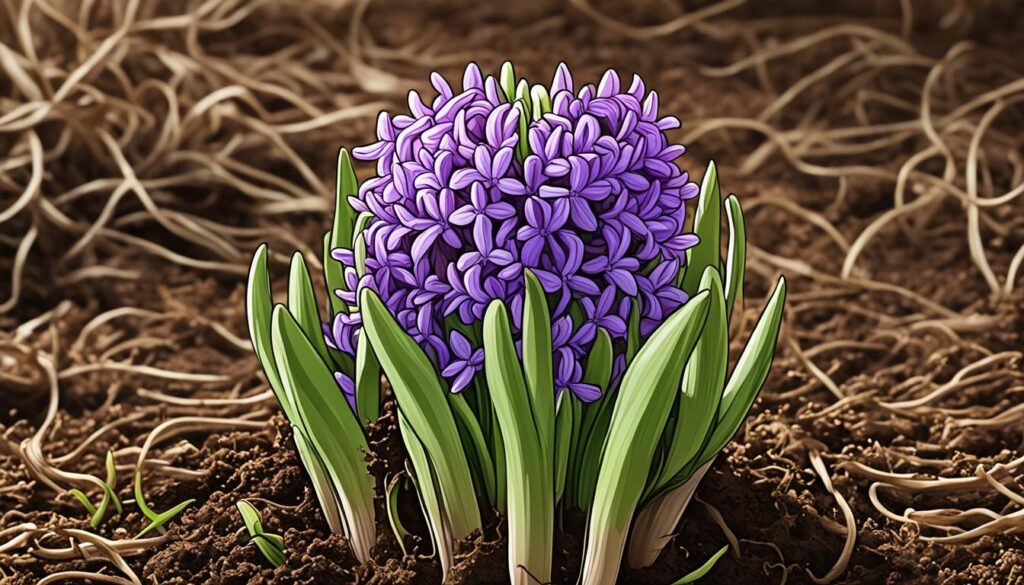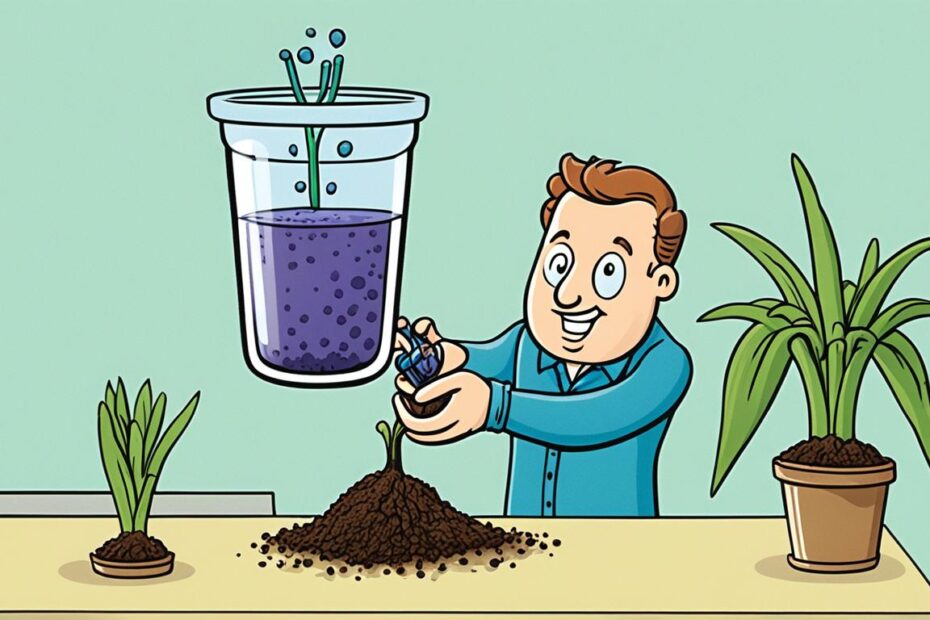Have you ever wondered if it’s possible to grow hyacinth bulbs from water and then transplant them to soil? You may be surprised to know that it is indeed possible, and it can be a rewarding experience for any gardening enthusiast.
Transplanting hyacinth bulbs from water to soil allows you to enjoy the beauty and fragrance of these vibrant flowers right in your own garden. Not only will you be able to witness the growth and blooming process, but it also gives you a sense of satisfaction in nurturing plants from their earliest stages.
Key Takeaways:
- You can successfully transplant hyacinth bulbs from water to soil.
- Choosing and preparing the bulbs properly is essential for successful transplantation.
- Planting the bulbs in a suitable container ensures their healthy growth.
- Proper care and maintenance are crucial for the success of the transplanted bulbs.
- Transplanting hyacinth bulbs can be a rewarding and satisfying gardening experience.
Choosing and Preparing the Bulbs
Before transplanting your hyacinth bulbs from water to soil, it’s important to choose and prepare the bulbs properly. This step will ensure the success of your transplanted hyacinths and their ability to thrive in the soil.
When selecting hyacinth bulbs, look for healthy bulbs that are firm and free from any signs of damage or disease. Choose bulbs that are large and plump, as they are more likely to produce robust blooms.
If possible, consider purchasing pre-chilled bulbs. These bulbs have already been exposed to a cooling period and are ready for planting. Pre-chilled bulbs eliminate the need for you to cool them yourself, saving you time and ensuring optimal growth.
If pre-chilled bulbs are not available, you can cool the bulbs yourself. Place the bulbs in a brown paper bag or a box lined with peat moss or vermiculite. Store the bulbs in a cool, dark area with temperatures between 35-45°F (2-7°C) for 12-14 weeks. The cooling period allows the bulbs to undergo a natural dormant phase, setting them up for healthy growth and blooming.
| Benefits of Pre-Chilled Bulbs | Benefits of Cooling the Bulbs Yourself |
|---|---|
| – Ready for immediate planting | – More cost-effective |
| – Higher success rate | – Greater control over the cooling process |
| – Ensures even chilling | – Opportunity to observe bud development |
Whether you choose pre-chilled bulbs or cool the bulbs yourself, the important thing is to provide the bulbs with the necessary cooling period. By doing so, you’re setting the stage for beautiful, vibrant hyacinth blooms in your garden.

Planting the Hyacinth Bulbs in Soil
When it comes to transplanting hyacinth bulbs from water to soil, proper planting techniques are crucial for the successful growth and blooming of these beautiful flowers. In this section, we will guide you through the step-by-step process of planting hyacinth bulbs in soil, ensuring that you provide the right conditions for their root development and overall health.
First and foremost, it is essential to select a suitable container for planting your hyacinth bulbs. A bulb vase or a shallow pot with drainage holes will work best for this purpose. Ensure that the container is large enough to accommodate the bulb comfortably.
- Pro Tip: If you are planting multiple bulbs, consider using a wider container to allow them enough space to grow.
Next, fill the container with well-draining soil. Hyacinth bulbs thrive in soil that is rich in organic matter and provides good drainage. A mix of garden soil and compost is a suitable choice for ensuring the bulbs’ healthy development.
Now it’s time to plant the hyacinth bulbs in the prepared soil. Hold the bulb with the root end facing down, and gently place it on top of the soil in the container. The root end is usually the flatter side of the bulb, while the pointed end is where the flowers will emerge.
Make sure that the bulb is not in direct contact with the soil. This prevents excess moisture around the bulb and helps prevent rot. Instead, the bulb should be slightly elevated, resting on top of the soil.
Expert Tip: To create a visually appealing arrangement, you can plant multiple bulbs in the same container, spacing them evenly and ensuring that they are not touching each other.
Once you have properly positioned the bulbs in the container, give them a gentle watering. Hyacinth bulbs require moist but not waterlogged soil for optimum growth. Avoid overwatering, as it can lead to root rot and other issues.
Now that you have successfully planted your hyacinth bulbs in soil, it’s time to provide them with the right care and conditions for their growth. In the next section, we will guide you through the essential steps to ensure the health and vitality of your transplanted hyacinth bulbs.
Yes, it is possible to add the title=”Planting the Hyacinth Bulbs in Soil” attribute to the image tag.
Caring for Transplanted Hyacinth Bulbs
Now that you’ve successfully planted your hyacinth bulbs in soil, it’s important to provide them with the proper care to ensure their growth and blooming. Here’s what you need to do:
- Store in a Cool, Dark Place: After planting the bulbs, find a cool, dark place such as a basement or cellar where they can remain undisturbed. This environment will encourage root development during the initial stage. Remember, cool and darkness are key to establish a strong foundation for your hyacinths. Be patient; they’ll be ready for the next step once the roots have developed.
- Move to a Warm, Bright Spot: When shoots start to appear, it’s time to relocate your hyacinth bulbs to a warm and bright spot. This can be a windowsill with plenty of sunlight or a well-lit area in your garden. Hyacinths thrive in sunlight, so providing them with a warm and bright environment will support their growth and flowering.
- Water Regularly: Hyacinths require consistent watering to maintain healthy growth. Keep the soil moist, but avoid overwatering as excessive moisture can lead to rot. Monitor the moisture level by checking the soil with your fingers. If it feels dry, water the bulbs gently. Remember, consistency is key.
By following these care instructions, your transplanted hyacinth bulbs will flourish and reward you with their lovely blooms. Stick to the cool-dark-warm-bright routine and maintain proper watering to ensure their growth and vitality.

Seasonal Care Overview
| Care | Season |
|---|---|
| Store in a cool, dark place | Fall to early winter |
| Move to a warm, bright spot | Mid-winter to early spring |
| Water regularly | Throughout the growth cycle |
Conclusion
Transplanting hyacinth bulbs from water to soil is a gardening technique that can lead to great success and satisfaction. By following the proper steps and providing the right care, you can enjoy the beauty and fragrance of blooming hyacinths in your garden.
When you successfully transplant hyacinth bulbs, you are not only creating a visually stunning display, but you are also cultivating a sense of accomplishment. Watching the bulbs grow and flourish in the soil can bring a deep sense of joy and fulfillment.
By choosing and preparing the bulbs correctly, planting them with care, and providing the right conditions, you are setting yourself up for success. Remember to store the bulbs in a cool, dark place until the roots develop, and then move them to a warm, bright spot once shoots appear. Regular watering will also help the bulbs thrive.
So, if you’re ready to add a touch of beauty and elegance to your garden, why not try transplanting hyacinth bulbs? With a little effort and attention, you can create a vibrant and enchanting floral display that will bring you joy for years to come.
FAQ
Can I transplant hyacinth bulbs from water to soil?
Yes, you can successfully transplant hyacinth bulbs from water to soil. By following the proper steps and providing the right care, you can enjoy beautiful blooming hyacinths in your garden.
How do I prepare hyacinth bulbs for transplantation?
Before transplanting hyacinth bulbs from water to soil, it is recommended to purchase pre-chilled bulbs if possible. If pre-chilled bulbs are not available, you can cool the bulbs in a dark area for 12-14 weeks to mimic the chilling period they require for growth.
What kind of container should I use for planting hyacinth bulbs in soil?
Choose a suitable container and fill it with water. Place the bulb on top of the container with the root end facing down. Make sure that the bulb is not touching the water to prevent rotting.
Where should I store the transplanted hyacinth bulbs?
After planting the hyacinth bulbs in soil, store them in a cool, dark place until the roots develop. This will provide the bulbs with the ideal conditions for growth.
What care is required for transplanted hyacinth bulbs?
Once shoots appear, move the bulbs to a warm, bright spot where they can receive adequate sunlight. Water the bulbs regularly, ensuring that the soil is moist but not overly saturated.
